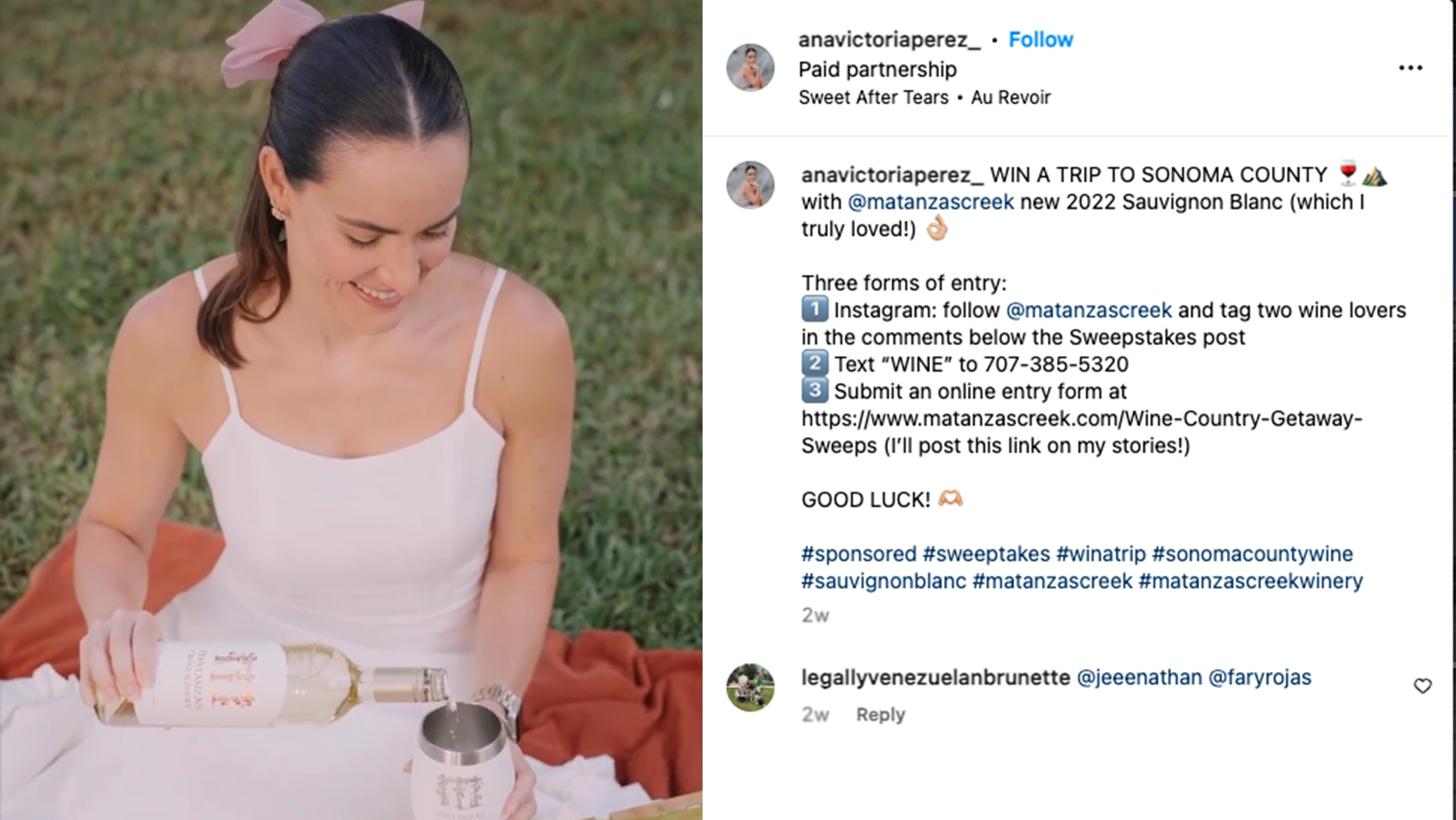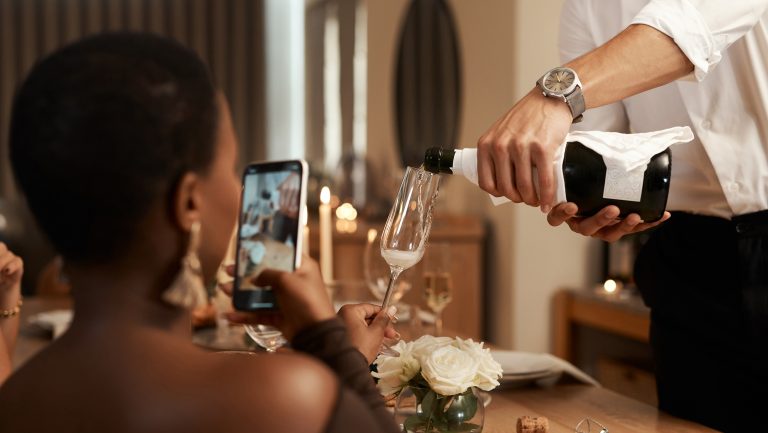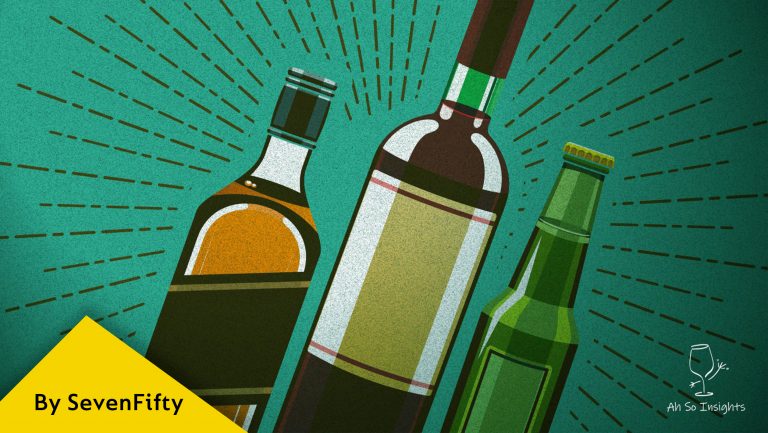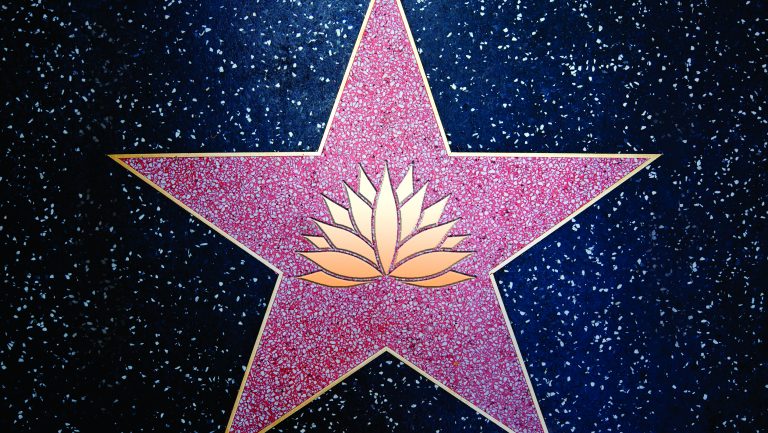Social media influencers are not new to the wine landscape, but they are sticking around—and wine businesses are putting marketing dollars behind them. Over the last several years, influencers have proven to be an essential part of a brand’s marketing plan as consumers spend more time browsing and buying products on social media.
According to an Ogilvy study, 75 percent of marketers now actively engage in influencer marketing, with 93 percent of them planning to amplify their influencer campaigns. Kristen Reitzell, the senior VP of communications and digital marketing at Jackson Family Wines, estimates that they work with influencers across two-thirds of their 40 wineries worldwide.
At Colangelo & Partners, their client La Crema engaged in an influencer partnership with Erin Berrebi, who has 103,000 Instagram followers. The campaign secured an earned media value (a metric used to calculate the value of a promotional effort by a third party) of $9,797.83 based on a partnership cost of $2,500, over 34,000 impressions, and a 2.84 percent engagement rate—a success by several measures.

Don’t miss the latest drinks industry news and insights. Sign up for our award-winning newsletters and get insider intel, resources, and trends delivered to your inbox every week.
It can sometimes be difficult to see the value of using influencers, but for the wine brands that have committed to these collaborations, the benefits are clear. Here, marketing experts share what makes influencers an important part of any marketing strategy.
The Value of Wine Influencers
Consumers use social media to aid in buying decisions, regardless of their age. According to data from CGA by NIQ, 83 percent of Gen Z consumers say they have purchased food or drink because they saw it on social media platforms. And according to data from CRM Essentials, 46 percent of baby boomers have purchased products in direct response to social media content.
Social media marketing is effective in part because influencers excel at leveraging specific niches and reaching hyper-targeted audiences with cross interests. In contrast, traditional marketing and advertising makes sense for brands with significant budgets to reach broad audiences.
“Over the years, we’ve evolved from dipping our toes in the influencer waters, to it becoming an integral part of our marketing strategies,” says Reitzell. “Consumers are still looking at multiple touchpoints to find, discover, and engage with brands. Influencers don’t replace any aspect of traditional media or online media.” The key is to strike the right balance between several marketing channels—including social media.
Successful influencers build their followings authentically and have the benefit of being a third party in the conversation, adding credibility and trust to back up a brand’s message. “Influencers have a diverse audience reach, and they have the ability to reach target audiences that perhaps brands themselves are not able to,” says Alisha Zaveri, an account director for digital at Colangelo & Partners.
How Influencer Collaborations Unfold
Influencer collaborations can take many different forms, including sampling programs, campaigns, event partnerships, and destination trips. Brands may choose to engage in different types of collaborations based on their goals and resources.
Sampling programs, which consist of sending wine samples to influencers with no specific deliverables or payment, can garner authentic and organic content from the influencer. This type of collaboration can work well with micro- and nano-influencers, which are defined as influencers with 100 to 10,000 followers.

Colangelo recently launched a sampling partnership called the Wine Influencer Ambassador Program. The idea came from influencers who asked questions about what new campaigns are coming up, what new clients they’re working with, or expressing interest in learning about a new region. “Since we have great relationships with wine influencers across the U.S., why don’t we leverage our clients in a way, where clients might not have existing budgets or might not be 100 percent convinced of the ROI with influencer marketing?” says Zaveri. Clients are seeing blogs, stories, posts, and reels from influencers participating in the program and consequently might consider investing in influencer campaigns in the future.
Another option is an influencer trip where attendees immerse themselves in a region or a brand. This type of collaboration can benefit a brand not just from the boost of impressions and followers, but from the generation of evergreen content that can be used as marketing collateral for months or years to come.
“The Chianti Classico consortium came to us and asked, ‘how do we reach younger consumers?’” says Zavari. In response, Colangelo organized an influencer campaign featuring a press trip to the region for five WSET-certified influencers. All content was organic with no expected deliverables and no payment, except for the cost of the trip. The results included over 300 pieces of organic content with 200,000 impressions and over 12,000 engagements. The consortium gained over 300 new followers to their Instagram page in the span of 10 days. According to Zaveri, “The pieces of content delivered were highly engaging and reused by Chianti Classico as evergreen content for months to follow.”
Professionals in the influencer space balance organic versus sponsored content to maintain credibility with their audience. “As a wine professional, I recognize that credibility and authenticity are important,” says Maryland-based wine educator and influencer Desiree Harrison-Brown, who has 16,700 Instagram followers.
Long-term partnerships with brands is the ultimate goal for many influencers. “I want brands to be more open to long-term partnerships rather than one-off posts,” says Harrison-Brown. “Given the volatility of social media, I think long-term partnerships create more brand awareness, build trust, and create more opportunities for feedback from my audience.”
On the brand side, both Colangelo and Jackson Family Wines aim to work with influencers who have an engagement rate over one percent. “Their content has to resonate with you. It has to feel authentic to the brand that you’re trying to associate them with,” says Reitzell.
How to Measure Success
The key metrics used to measure the success of an influencer campaign vary, but often include views (reach and impressions), engagement (likes, comments, shares, and saves), and conversion. Conversion can be defined as sales (for instance, the use of an affiliate code) or any of the engagement metrics listed above. To collect this data, influencers are asked to share screenshots for the brands to measure the success of the campaign.
Tagger is a tool agencies and brands use to harness the power of data to drive creator and influencer marketing strategies. According to Zaveri, Colangelo uses the platform to vet influencers, track campaign metrics, and now calculate the earned media value (EMV) of a campaign. “A key metric to gauge whether the collaboration was a success or not is if the EMV is at least 1.5 times the partnership cost,” says Zaveri. “The initial stages of vetting an influencer include a quantitative and qualitative analysis of their past content, approximate EMV, and alignment with the brand. Due to the thorough vetting process, most, if not all, collabs do meet [that EMV threshold].”

Success is often driven by authentic storytelling on behalf of the influencer. A frequent problem with influencer collaborations is brands and PR trying to exert too much control over the final assets. “I have found when a brand tries to have too much control over a campaign, it usually creates issues and the content doesn’t do as well,” says Brooke Martin, who has 81,900 Instagram followers. Reitzell offers this advice for brands and firms new to navigating these collaborations: “You have to be willing to collaborate with ease. Remember not to try and guardrail too much, otherwise you’re just getting what you would have produced.”
Using influencers to create evergreen content can replace some brands’ in-house content creation. One brand balked at the added cost to engage in influencer marketing. “How much do you spend on photography a year?” Reitzell asked. The reply: $10,000. “What if you took $2,500 of that and worked with a couple micro-influencers because you love their content,” Reitzell recalls suggesting.
Zaveri agrees: “Brands might not have big budgets when it comes to content and digital marketing. Working with influencers is an effective way to be able to build that content and asset bank.”
Data has confirmed that consumers utilize social media to help make buying decisions. As a key part of the social media ecosystem, influencers are essential and worth pursuing as part of an overall marketing plan. Influencer spend is significant and increasing, according to multiple brands both inside and outside of the wine industry. Their ability to communicate authentically and build the confidence and trust of their audiences is something that a brand cannot do alone. Partnering with the right influencer to tell a brand story is the key to a successful influencer brand collaboration.

Dispatch
Sign up for our award-winning newsletter
Don’t miss the latest drinks industry news and insights—delivered to your inbox every week.
Brianne Cohen is a Los Angeles based event producer, certified sommelier, wine educator, and wine writer. Brianne regularly judges at international wine competitions and holds the WSET Diploma certificate and a Master of Business Administration from Loyola Marymount University.






